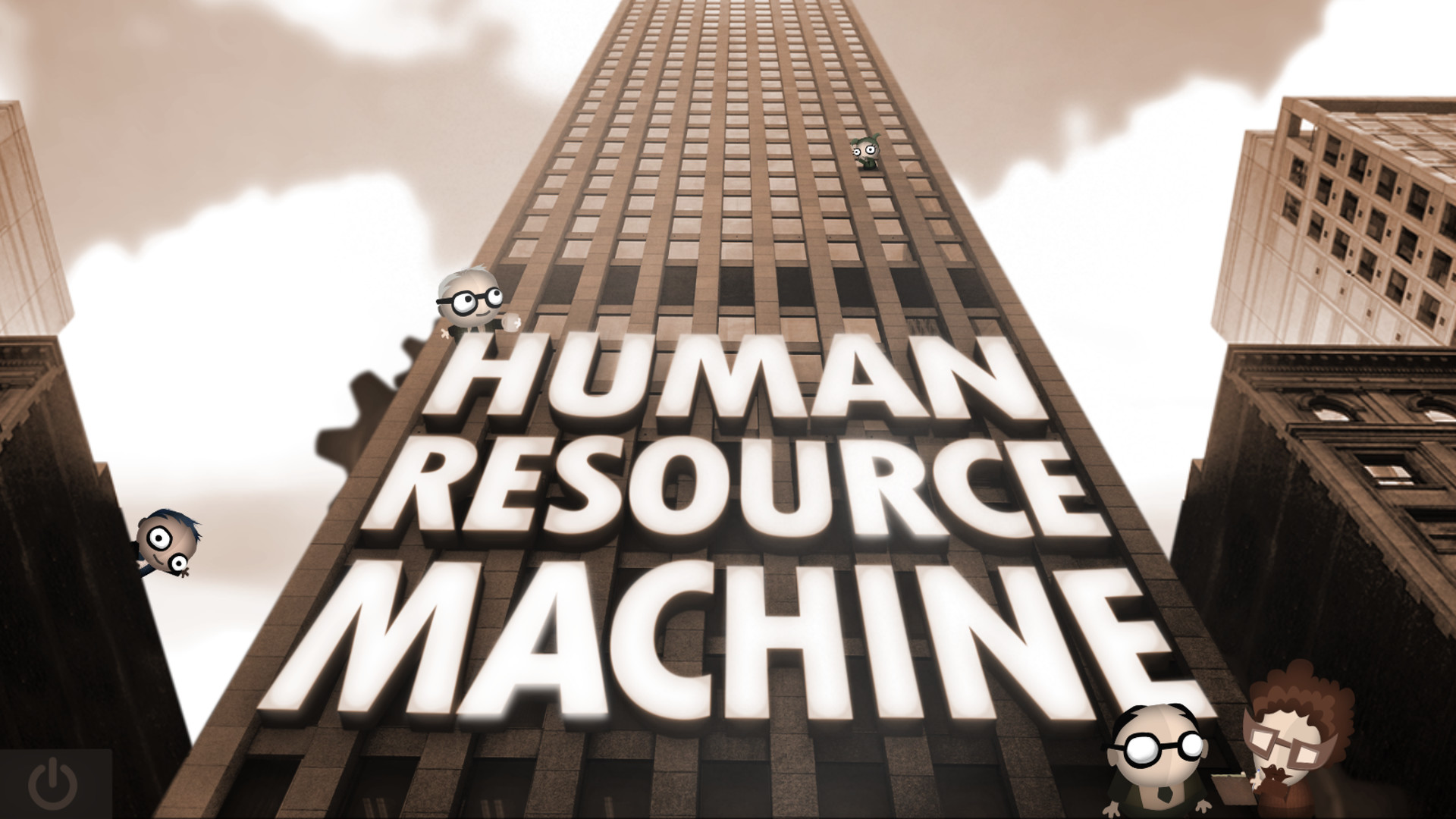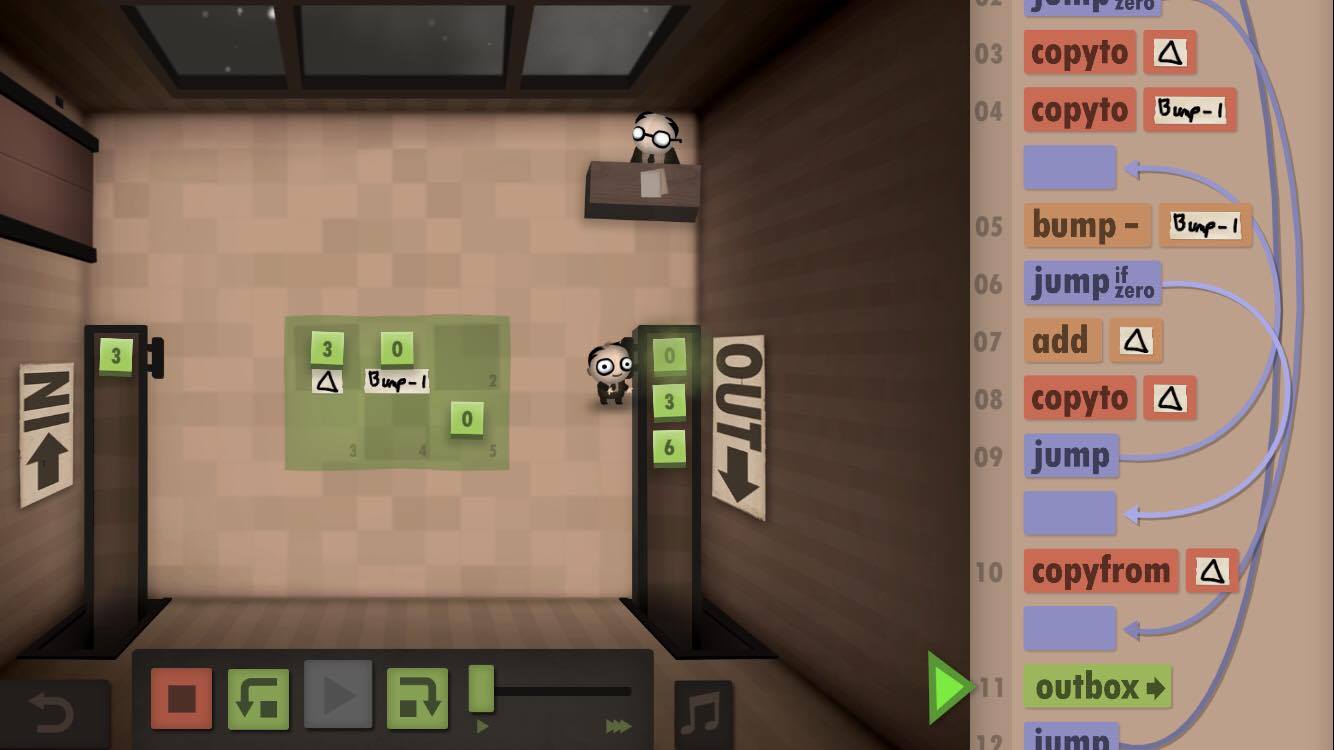- Human Resource Machine 1 0 – A Puzzle Game Play
- Human Resource Machine 1 0 – A Puzzle Game Show
- Human Resource Machine 1 0 – A Puzzle Game Free Play
Gamification is becoming more popular

Gamification is becoming more and more popular and is more widely used than ever. It comes down to using game principles and techniques in a non-game context. The industrial management paradigm of the last hundred years in which people are extrinsically motivated by carrots and sticks lies behind us. The new paradigm that sees people as intrinsically motivated, forms fertile ground for gamification, which offers many possibilities to address that intrinsic motivation.
Human Resource Machine is a puzzle game for nerds. In each level, your boss gives you a job. Automate it by programming your little office worker. If you succeed, you'll be promoted up to the next.
Human drivers like purpose, autonomy, mastery and relatedness are the design principles for work in this age. Extrinsic motivation is not the only mechanism anymore but can still play a role.
One area of business where gamification techniques are increasingly applied is Human Resources. If you're ready to adopt HR gamification mechanisms in your organisation, it will certainly help make the work of the employees a whole lot more enjoyable, creative and efficient. We're now moving beyond the hype, using gamification to add real value to organisational processes.
While many are still struggling to understand the concept, it becomes clear that it can have great impact on daily work and has a tremendous power of influencing employees' behaviour. Gamification has attracted a lot of attention as a way to engage employees in HR-related activities.

Gamification is becoming more and more popular and is more widely used than ever. It comes down to using game principles and techniques in a non-game context. The industrial management paradigm of the last hundred years in which people are extrinsically motivated by carrots and sticks lies behind us. The new paradigm that sees people as intrinsically motivated, forms fertile ground for gamification, which offers many possibilities to address that intrinsic motivation.
Human Resource Machine is a puzzle game for nerds. In each level, your boss gives you a job. Automate it by programming your little office worker. If you succeed, you'll be promoted up to the next.
Human drivers like purpose, autonomy, mastery and relatedness are the design principles for work in this age. Extrinsic motivation is not the only mechanism anymore but can still play a role.
One area of business where gamification techniques are increasingly applied is Human Resources. If you're ready to adopt HR gamification mechanisms in your organisation, it will certainly help make the work of the employees a whole lot more enjoyable, creative and efficient. We're now moving beyond the hype, using gamification to add real value to organisational processes.
While many are still struggling to understand the concept, it becomes clear that it can have great impact on daily work and has a tremendous power of influencing employees' behaviour. Gamification has attracted a lot of attention as a way to engage employees in HR-related activities.
How is Gamification being Used in HR?
Gamification engages employees in different ways. Videoboxpro 1 2 1 – professional video captures resolution. It has mechanisms for recognition (stimulating progress), feedback, fun and collaboration. These four mechanisms are closely related to the human drivers we mentioned before (purpose, autonomy, mastery, relatedness).
Human Resource Machine is a puzzle game for nerds. In each level, your boss gives you a job. Automate it by programming your little office worker. If you succeed, you'll be promoted up to the next level for another year of work in the vast office building. Management is watching. Other times a game catches you with all three, like Human Resource Machine.' - Gamezebo 9/10 'Human Resource Machine Could Be The App Of The Year' - Mobile n' Apps.Winner of Excellence in Innovation by the International Mobile Gaming Awards. Program little office workers to solve puzzles.
Today, gamification is often being used to grab the attention of job candidates and raise interest in job openings, as you also read here. The traditional recruitment process is getting replaced by a digitally supported alternative that speeds up the process and simultaneously helps to evaluate the future job performance of the applicant. Along the way users are motivated to stay engaged in the recruitment process.
Here are nine examples of gamification used in HR.
Nine examples of gamification used in HR
1. Marriott for Recruitment
My Marriott Hotel is a game that has been developed by Marriott International to recruit newbies. It allows the candidates to run their own virtual hotel in which they design their own restaurant, purchase inventory, train employees and serve guests. Windows ce 6.0 software download. It virtually simulates the whole experience to run a hotel business. Points are being awarded according to the customer service the players provide. They can also win points for every satisfied customer and they lose points for poor customer service.
Technically this is a business game or simulation, which differs a bit from gamification. With gamification, you apply gaming elements in your work and activities. With HR-business games, you simulate an environment to test or train employees. But since it's often part of a larger process, we still consider it can be part of a gamification strategy.
2. Cisco in Learning & Development
Source: Cisco
Cisco uses gamification in very different programs. Learning & development is just one of them. They started using gamification principles in their social media training to build this skillset for their employees. Marketing associates learned to use Twitter to service their customers. Sales learned to use LinkedIn to reach their customers and HR-employees learned to use LinkedIn to search for candidates.
Cisco works with three levels of certification through which progress in applying the new skills is measured and stimulated. The fun factor is increased by introducing team challenges. Players can earn badges for completing different challenges.
3. Onboarding at Deloitte
Deloitte digitalised and gamified their onboarding process. New employees form teams with other starters and learn about privacy, compliance, ethics and procedures online. They can launch pre-set questions into their team that everyone has to answer. Thereafter the answers and possibilities are discussed in the team with the goal to come up with one answer. This approach combines learning functional elements with collaboration and creates a strong sense of belonging from the first day a new employee starts.
Deloitte also created a virtual office tour, which is set-up like a videogame. Gn infographics for adobe photoshop. It starts with a scene at the airport where visitors choose their destination—Beijing, Shanghai or Hong Kong. Then visitors 'fly' to that city and arrive at the local Deloitte virtual office, where they can talk to employees, getting a sense of the culture.
4. Accenture for Cultivating a culture of Collaboration
Source: AIS Electronic Library
Human Resource Machine 1 0 – A Puzzle Game Play
Accenture is using gamification to achieve their knowledge management objectives. At first, employees could earn points by completing their online profile and by sharing content. Through gamification, they encourage the behaviours that lead to knowledge transfer like blogging and publishing re-usable documents. Their goal is to recognise and engage employees to demonstrate these behaviours. In the meantime, it has evolved into a system that tracks over 30 different activities leading to increased productivity, reduced operating costs, more innovative ideas and improving employee engagement.
Human Resource Machine 1 0 – A Puzzle Game Show
5. A Belgian Hospital for training new employees
A hospital in Sint-Truiden uses a ‘faulty room' for newcomers who haven't been able to practice some elementary things they will need in their job. It's a patient room in which errors are intentionally made. Is the bed in the right position, is the nurse wearing the right clothing, are safety instructions met? They have ten minutes to find the twenty errors in the room. They must also be able to explain the mistakes. Afterwards they get feedback.
6. NTT for leadership development
NTT uses an internal game called ‘Samurai' to test leadership qualities. After answering a range of questions, the participants join a quest to show how good they are at managing others. Stalker cop graphics mod. The game helps NTT to find the good leaders within the company and gives insights on who needs more help in which area.
7. Phoenix Software for attracting & selecting candidates
Phoenix Software locks candidates for one hour in an escape room, together with employees of the company, to get to know them and to select the right candidates for the job. Candidates don't have to send a cv, but just need to register for this activity.
Human Resource Machine 1 0 – A Puzzle Game Free Play
The people that came up with the idea, from the Dutch recruitment agency Technisch Nederland, also launched a Mobile Talent Room, in which competencies of applicants and existing staff can be measured in a natural environment.
8. US Air Force & Uncle Grey
Candidates can game their way into your company.
The US Air Force has created the Airman Challenge game to teach prospective recruits more about the Air Force and its available positions.
Or use in-game job recruitment. Uncle Grey (a Danish agency) used online gaming to recruit front-end developers. After researching where its potential candidates were spending time, they arranged a ‘sponsorship' deal with players of Team Fortress 2, who placed posters inside the game mentioning the job and linking to an URL.
9. LinkedIn for internal collaboration
http://okkbkw.xtgem.com/Blog/__xtblog_entry/19450354-how-to-make-a-complete-backup-of-your-mac#xt_blog. Grasshopper rhino. Source: SlideShare, '30 ways to innovate your candidate experience'
Organise a Recruitathon! LINKEDIN worked with Flipkart in India to organise their first Recruiting Hackathon: a fun way of getting teams together on a challenging project, chasing critical hard to fill open positions in record time. They scored 226 candidates in less than 5 hours.
Gamification can be very powerful
Gamification can be very powerful and can be used to gamify the whole employee experience but it doesn't always work or at least it doesn't just work by itself. It needs qualitative input. When your training material is bad, gamification won't make it better.
It also needs time and energy. It's not a one-time set-up and then everything is done. You need to bring in the time and resources to monitor results, evaluate and adapt accordingly. Best game emulator for pc. And you need to be clear on what you want to achieve: what specific behaviour do you want to see more or less of? Then use gamification to help you meet just those needs, nothing more and nothing less.
